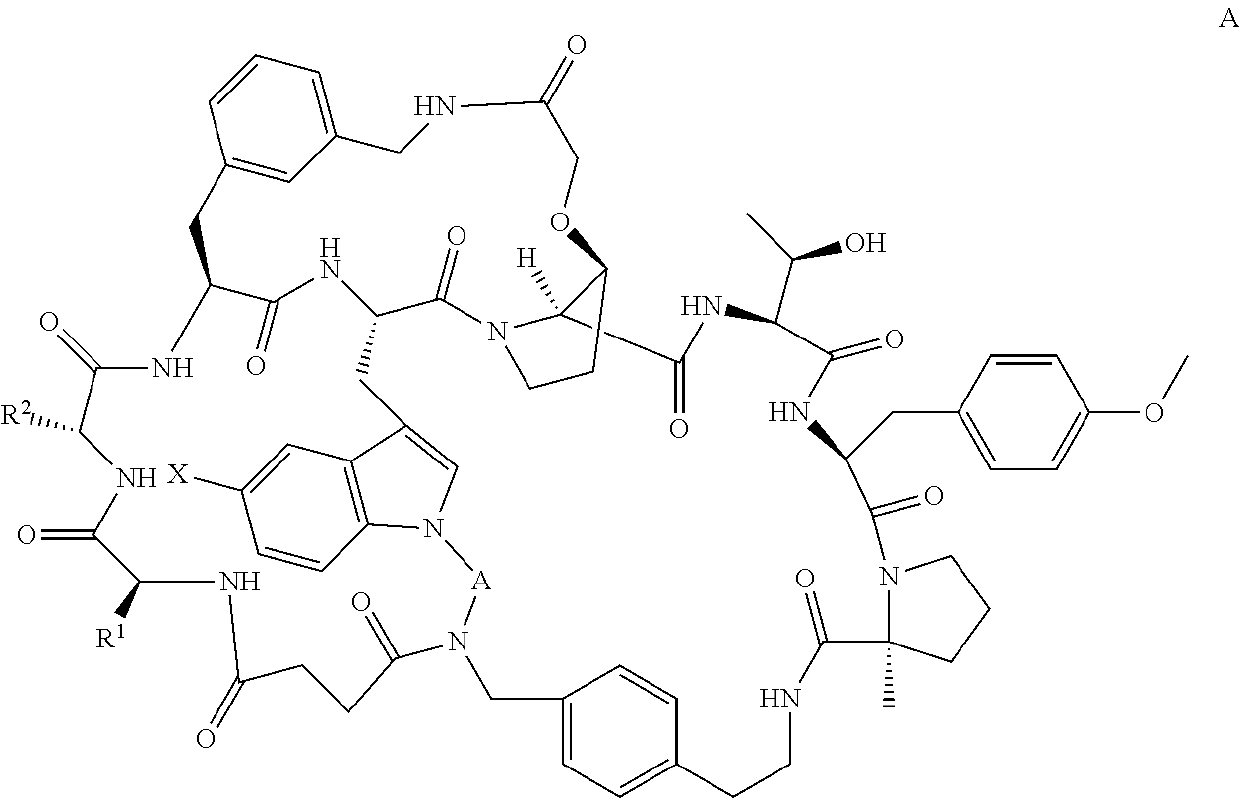Pcsk9 antagonist compounds
a technology of pcsk9 and compounds, which is applied in the direction of drug compositions, peptide/protein ingredients, metabolic disorders, etc., can solve the problem of compromising the liver's ability to remove ldl cholesterol from the circulation
- Summary
- Abstract
- Description
- Claims
- Application Information
AI Technical Summary
Benefits of technology
Problems solved by technology
Method used
Image
Examples
example 1
SYNTHESIS OF EXAMPLE 1
[0483]
Step A—Synthesis of Intermediate 1a
[0484]To a solution of 2,2-dimethyl-4-oxo-3,8,11-trioxa-5-azatridecan-13-oic acid (900 mg, 3.42 mmol) in DMF (10 mL) at RT were added NaHCO3 (144 mg, 17.1 mmol) and MeI (0.641 mL, 10.3 mmol). The mixture was stirred for 24 h then diluted with brine and extracted with EtOAc. The combined organic layers were washed with brine, dried over MgSO4 and filtered, and the filtrate was concentrated. The residue was purified by MPLC over silica gel (eluting with a gradient of 1%-50% EtOAc in PE) to give la. LC / MS: [M+H]+=278.2.
Step B—Synthesis of Intermediate 1b
[0485]A solution of 1a (770 mg, 2.78 mmol) in 4 M HCl in dioxane (2 mL) was stirred at RT for 2 h then concentrated under reduced pressure. The residue was re-dissolved in DCM (5 mL) and concentrated under reduced pressure to 1b. LC / MS: [M+H]+=178.2.
Step C—Synthesis of Intermediate 1c
[0486]To a solution of 18-(tert-butoxy)-18-oxooctadecanoic acid (347 mg, 0.936 mmol) in DMF ...
example 2
SYNTHESIS OF EXAMPLE 2
[0492]
Step A—Synthesis of Intermediate 2a
[0493]To a solution of (S)-22-(tert-butoxycarbonyl)-43,43-dimethyl-10,19,24,41-tetraoxo-3,6,12,15,42-pentaoxa-9,18,23-triazatetratetracontan-1-oic acid (250 mg, 0.295 mmol, the synthesis of which is described in Example 9, page 90, of WO 2009 / 115469) in DMF (300 μL) and water (50 μL) at 0° C. were added intermediate A (103 mg, 0.355 mmol), HATU (124 mg, 0.325 mmol) and DIPEA (153 mg, 1.18 mmol). The mixture was stirred at RT for 1 h then quenched with water (50 μL) and purified by reverse phase MPLC over C18 (eluting with a gradient of acetonitrile in water (+0.05% TFA)). The fractions containing the desired product were combined and concentrated. The residue was re-dissolved in DCM (5 mL) and 4 N HCl in dioxane (0.1 mL) then concentrated under reduced pressure. The residue was re-dissolved in acetonitrile (10 mL) and water (10 mL), treated with 1 N aqueous HCl (0.4 mL) at 0° C. and lyophilized to afford 2a. LC / MS: [M]+=...
example 3
SYNTHESIS OF EXAMPLE 3
[0497]
Step A—Synthesis of Intermediate 3a
[0498]To a solution of 2,2-dimethyl-4-oxo-3,8,11-trioxa-5-azatridecan-13-oic acid (3.33 g, 12.6 mmol) in DMF (30 mL) at 0° C. were added 1b (2.70 g, 12.6 mmol), HATU (4.80 g, 12.6 mmol) and DIPEA (6.53 g, 50.5 mmol) then the solution was stirred at RT for 1 h. The mixture was diluted with brine, extracted with EtOAc, washed with brine, dried over MgSO4 and filtered. The filtrate was concentrated under reduced pressure and the residue was purified by MPLC over silica gel (eluting with a gradient of 1%-8% MeOH in DCM) to provide 3a. LC / MS: [M+H]+=445.3.
Step B—Synthesis of Intermediate 3b
[0499]A solution of 3a (3.00 g, 7.10 mmol) in 4 M HCl in dioxane (30 mL) was stirred at RT for 2 h then concentrated. The residue was re-dissolved in DCM (30 mL) and concentrated under reduced pressure to afford 3b. LC / MS: [M+H]+=323.2.
Step C—Synthesis of Intermediate 3c
[0500]To a solution of (S)-4-(((benzyloxy)carbonyl)amino)-5-(tert-butox...
PUM
| Property | Measurement | Unit |
|---|---|---|
| pH | aaaaa | aaaaa |
| pressure | aaaaa | aaaaa |
| pH | aaaaa | aaaaa |
Abstract
Description
Claims
Application Information
 Login to View More
Login to View More - R&D
- Intellectual Property
- Life Sciences
- Materials
- Tech Scout
- Unparalleled Data Quality
- Higher Quality Content
- 60% Fewer Hallucinations
Browse by: Latest US Patents, China's latest patents, Technical Efficacy Thesaurus, Application Domain, Technology Topic, Popular Technical Reports.
© 2025 PatSnap. All rights reserved.Legal|Privacy policy|Modern Slavery Act Transparency Statement|Sitemap|About US| Contact US: help@patsnap.com



